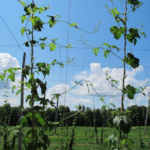While wild or naturalized hop plants are disbursed throughout the Northeast landscape, they have not been grown in this region on a commercial scale for the past 150 years. Prohibition laws of the 1920’s, the spread of hop downy mildew, and the expansion of hop production in the Pacific Northwest led to the disappearance of the hop industry in the Northeast. Recent and rapid growth in the craft beer industry has drastically increased the demand for local hop production. The UVM Extension NWCS team is beginning to evaluate local wild cultivars to better understand their potential commercial value.
In fall of 2016, wild hop plants were gathered from eight locations in Massachusetts, New York, and Vermont. A total of 10 wild hop species are being cultivated at Borderview hopyard.
Due to various growing conditions and hop characteristics, not all plants were harvested in 2017, and higher yields are expected in subsequent years! Six varieties were harvested and data on total yield and quality were obtained – the characteristics between the hop varieties differed greatly in:
- Susceptibility to pests
- Reactions to pesticide combinations
- Maturation rates
- Oil profiles and oil compositions
- Acid content
 The UVM Extension NWCS team will continue to monitor these differences in future years, as well as obtain additional wild hop samples and varieties to add to the hop database. Assessment of germplasm presents an opportunity to discover unique hop characteristics for a newly resurging Vermont crop. Each variety’s characteristics could provide new and distinct flavor profiles for brewers through variable acid and oil profile combinations. More information can be found in the full report on our Research page as well as hyperlinked below:
The UVM Extension NWCS team will continue to monitor these differences in future years, as well as obtain additional wild hop samples and varieties to add to the hop database. Assessment of germplasm presents an opportunity to discover unique hop characteristics for a newly resurging Vermont crop. Each variety’s characteristics could provide new and distinct flavor profiles for brewers through variable acid and oil profile combinations. More information can be found in the full report on our Research page as well as hyperlinked below:
http://www.uvm.edu/extension/cropsoil/wp-content/uploads/2017-Hop-Germplasm-Report.pdf